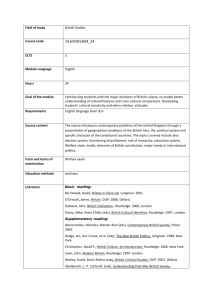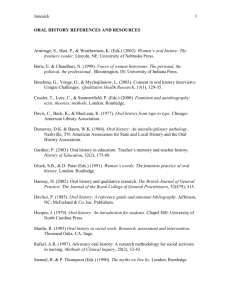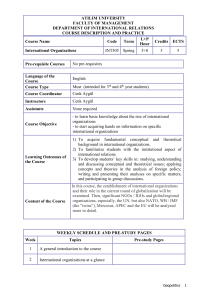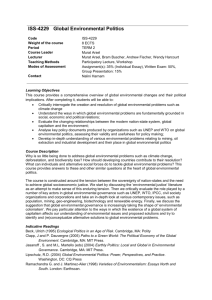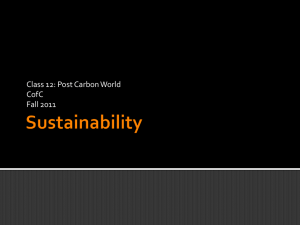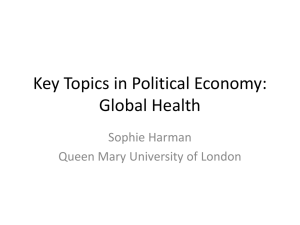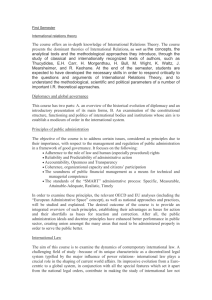Spring 2014 Syllabus for Poli 464
advertisement
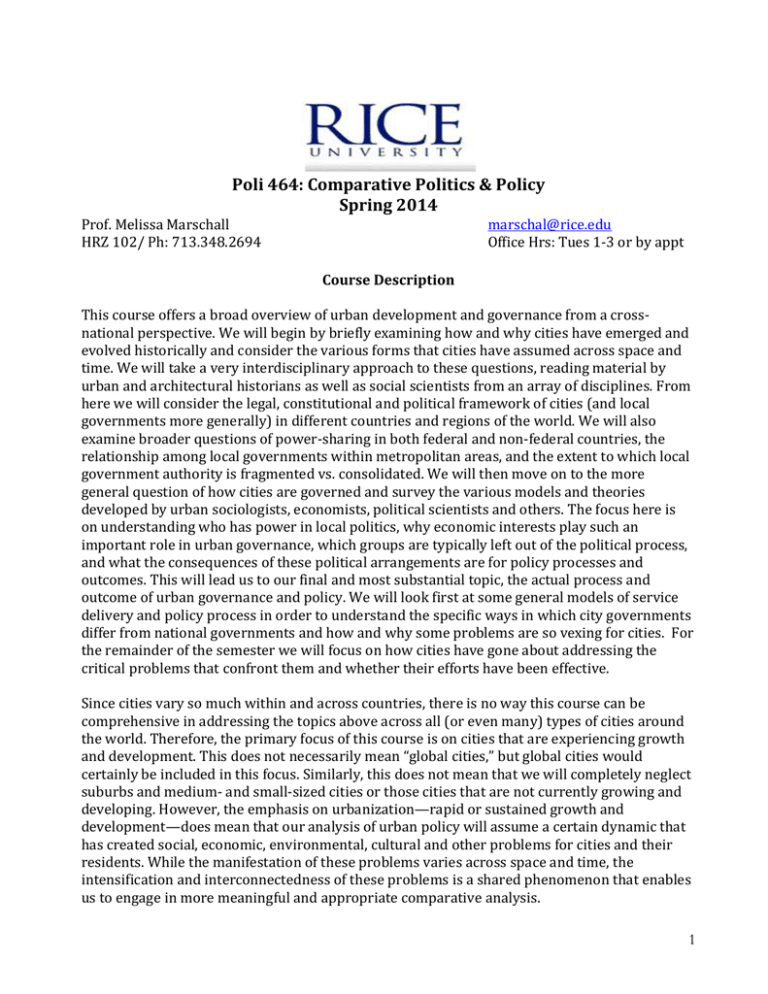
Poli 464: Comparative Politics & Policy Spring 2014 Prof. Melissa Marschall HRZ 102/ Ph: 713.348.2694 marschal@rice.edu Office Hrs: Tues 1-3 or by appt Course Description This course offers a broad overview of urban development and governance from a crossnational perspective. We will begin by briefly examining how and why cities have emerged and evolved historically and consider the various forms that cities have assumed across space and time. We will take a very interdisciplinary approach to these questions, reading material by urban and architectural historians as well as social scientists from an array of disciplines. From here we will consider the legal, constitutional and political framework of cities (and local governments more generally) in different countries and regions of the world. We will also examine broader questions of power-sharing in both federal and non-federal countries, the relationship among local governments within metropolitan areas, and the extent to which local government authority is fragmented vs. consolidated. We will then move on to the more general question of how cities are governed and survey the various models and theories developed by urban sociologists, economists, political scientists and others. The focus here is on understanding who has power in local politics, why economic interests play such an important role in urban governance, which groups are typically left out of the political process, and what the consequences of these political arrangements are for policy processes and outcomes. This will lead us to our final and most substantial topic, the actual process and outcome of urban governance and policy. We will look first at some general models of service delivery and policy process in order to understand the specific ways in which city governments differ from national governments and how and why some problems are so vexing for cities. For the remainder of the semester we will focus on how cities have gone about addressing the critical problems that confront them and whether their efforts have been effective. Since cities vary so much within and across countries, there is no way this course can be comprehensive in addressing the topics above across all (or even many) types of cities around the world. Therefore, the primary focus of this course is on cities that are experiencing growth and development. This does not necessarily mean “global cities,” but global cities would certainly be included in this focus. Similarly, this does not mean that we will completely neglect suburbs and medium- and small-sized cities or those cities that are not currently growing and developing. However, the emphasis on urbanization—rapid or sustained growth and development—does mean that our analysis of urban policy will assume a certain dynamic that has created social, economic, environmental, cultural and other problems for cities and their residents. While the manifestation of these problems varies across space and time, the intensification and interconnectedness of these problems is a shared phenomenon that enables us to engage in more meaningful and appropriate comparative analysis. 1 Course Objectives This course has specific goals with regard to the substantive knowledge it seeks to impart and the research skills it hopes to develop. With regard to the first objective, I hope students will gain a deeper and more profound understanding of each of the following: History, structure, and function of urban and metropolitan settlements Administrative, legal, and political aspects of policy and plan-making Different roles of government, governance, and citizenship in urban policy and governance History, theory, and process of urban policy and governance Economic, environmental, social, political, historical, and cultural influences on urban policy process and outcomes In terms of research skills, the organization, format and requirements of the course seek to build each of the following: Critical thinking abilities—class discussion, writing assignments, exam Research skills (Research design, literature review, identifying and assessing data sources and limitations, conducting field research) —course project/lab class Data analysis skills (Interpreting and synthesizing data, drawing inferences from specific observations to make more generalizable findings, comparative analysis, recognizing and accounting for limitations to findings) —lab project/lab class Qualitative analysis skills (Direct observation and analysis of primary and secondary qualitative data)—lab class/field research Communication skills (Written, oral and graphic communication, presentation strategies and methods)—field research, class presentations & final poster presentation Course Requirements1 Since this course covers rather substantial ground across both time and space, the reading list is quite broad and may appear a bit daunting. However, many of these readings are short and most are of a non-technical nature—so the reading list looks more intimidating than it actually is. It is imperative that you keep up with the reading and participate in class discussions. Moreover, to get the most out of this course, it will be necessary for you to engage the readings and to challenge both your own and each others’ preconceived notions about the ways in which “place” shapes how we view politics, government and policy. In addition to a midterm and final exam, grades will be based on several short writing assignments, including blogs and analytic essays. The purpose of the blog posts is to critically evaluate and comment on the readings. They should not be summaries of the readings. Casually reading the assigned articles is not likely not to produce very good results. You should therefore begin reading well before each class meeting, taking notes and posing questions as you read. Finally, class attendance and participation will constitute a meaningful portion of the final grade. Students will be responsible for leading the discussion of specific readings several If you have any conditions or challenges that may make it difficult for you to meet the requirements of this course, or that may cause you to require extra time on assignments, please let me know within the first two weeks of class so that we can make appropriate and equitable alternative arrangements. 1 2 times throughout the course of the semester. As a discussion leader, students should first present a brief summary (no more than 5 minutes) of the reading and then spend about 10 minutes critiquing various aspects of the research, approach, argument, and findings presented in the article. In most cases, the discussion leader will not have more than 15 minutes in total for his/her presentation. After the presentation, the class (myself included) will have the opportunity to ask questions of the presenter and to discuss the article in more detail. Grades will be determined as follows: Assignments & in-class work: Class participation & attendance: Exams: 40% 15% 45% Students are encouraged to keep track of their progress in this course and consult with me when they have questions or concerns. Please note that any query about grades should be done in person either during my office hours or by appointment—I will not discuss grades via email or telephone. The grading scale in operation for this course is provided below. A+ 100-98% A 97-94% A93-90% B+ 89-88% B 87-82% B81-80% C+ 79-78% C 77-72% C71-70% D+ 69-68% D 67-62% D61-60% Instructor Responsibilities I have high expectations not only for you but also for myself. You should expect that I will be prepared for class, read and return your work in a timely manner, and be mindful of the fact that each of you brings a different background, experience, and perspective to this course. By working hard and having fun, I hope to both learn from you and to empower you to develop a greater understanding and appreciation of cities, local politics, and the myriad ways in which “place” shapes how we live and view both ourselves and the world around us. 3 Course Topics and Schedule of Readings Jan 14: Course Introduction & Overview Part I: Background Jan 16: The Origins of Cities: How and when did cities emerge, why do they exist, and what are their main features? Kostof, Spiro. 1991. The City Shaped. Chpt 1: Introduction (pp. 9-41). London: Bulfinch Press. Palen, John J. 1997. The Urban World. Chpt 2: Emergence of Cities (pp20-60) Florida, Richard. 2013. “Why Our Cities Look and Work the Way They Do: A conversation with Sam Bass Warner and Andrew Whittemore about their new book, American Urban Form.” Atlantic Cities: Place Matters (Mar 28th) Wirth, L. (1938) “Urbanism as a Way of Life,” Reprinted in R. LeGates & F. Stout eds., The City Reader. New York: Routledge. pp. 189-197. [Ebook from Fondren] Jan 21/23: Urbanization, Urban Development and Change Davis, Kingley. 1965. “The Urbanization of the Human Population.” Scientific American, In City Reader 5th Edition, eds Richard LeGates & Frederic Stout. NY: Routledge. (p 2030). [Ebook from Fondren] Video: Chicago—City of the Century [Owlspace] UN Habitat (2009) 2009 Global Report on Human Settlements: Planning for Sustainable Cities. Ch. 2“Understanding the Diversity of Urban Contexts” http://www.unhabitat.org/pmss/listItemDetails.aspx?publicationID=2831 Supplemental Readings Savitch, Hank & Kantor, P. 2002. Cities in the International Marketplace. The Political Economy of Urban Development in North America and Western Europe, Ch. 1 (p.1-28) Bai, X. (2008) “The Urban Transition in China,” Chpt 20. In The New Global Frontier: Urbanization, Poverty and Environment in the 21st Century, eds Martine, George et al. Routledge. Rodriguez, Jorge and George Martine. 2008. “Urbanization Trends in Latin America and the Caribbean,” Chpt 21. In The New Global Frontier: Urbanization, Poverty and Environment in the 21st Century, eds Martine, George et al. Routledge. White, M. Mberu & Collison. 2008. “African Urbanization: Recent Trends & Implications,” Chpt 18. In The New Global Frontier: Urbanization, Poverty and Environment in the 21st Century, eds Martine, George et al. Routledge. Martinez-Fernandez et al. 2012. “Shrinking Cities: Urban Challenges of Globalization” International Journal of Urban and Regional Research 36 (1): 213-25 Jan. 28/30: Urban Problems—Inequality, Poverty, Violence, Environmental Degradation Video: Eukenopolis [Owlspace] Neuwirth, Robert. 2006. Shadow Cities. NY: Routledge. Prologue (pp. 1-22) 4 Wagstaff, Keith. 2013. “China's massive pollution problem: Air pollution has made many cities in China "barely suitable for living," and is making the population sick — and angry.” The Week. November 9. http://theweek.com/article/index/252440/chinasmassive-pollution-problem# Gizewski, Peter & Thomas Homer-Dixon. 1996. “Urban Growth and Violence: Will the Future Resemble the Past? Occasional Paper Project on Environment, Population and Security Washington, D.C.: American Association for the Advancement of Science and the University of Toronto. Florida, Richard. 2013. “Class-Divided Cities: Houston Edition--The eighth in our series exploring the class divides across America's largest cities and metros.” The Atlantic Cities: Place Matters (March 12th). Assignment 1: Statement of research question & preliminary field research proposal Part II: Local Politics & Governance—What do local governments do (what power do they have?) and why? Feb 4/6: Intergovernmental Relations & Power Sharing Goldsmith, Mike. 2012. “Cities in Intergovernmental Systems.” Chpt 8 in The Oxford Handbooks of Urban Politics, eds. K Mossberger, S. Clarke, P. John. NY: Oxford University Press Shah, Anwar. 2006. “A Comparative Institutional Framework for Responsive, Responsible and Accountable Local Governance,” Chapter 1 in Local Governance in Industrial Countries, ed. A. Shah. Washington, DC: World Bank. http://siteresources.worldbank.org/PSGLP/Resources/LocalGovernanceinIndustrial.pd f Sproats, K. 2002. Local government in Asia and the Pacific: A Comparative Analysis Bangkok: United Nations Economic and Social commission for Asia and the Pacific. http://www.unescap.org/huset/lgstudy/comparison1.htm [SH Lab Students] Nickson, Andrew. 2011. Where is Local Government Going in Latin America? A Comparative Perspective. Working Paper No6. Swedish Centre for Local Democracy. [BA Lab Students] Ozcan, Gul Berna 2000. “Local economic development, decentralisation and consensus building in Turkey.” Progress in Planning 54: 199-278. [IST Lab Students] Assignment 2: Country profiles Feb 11/13: Models of Local Politics--Service Delivery and Economic Development/Growth Peterson, Paul. 1981. City Limits. Chicago Univ Press. Chpts 1-3 Molotch, Harvey. 1976. “The City as a Growth Machine: Towards a Political Economy of Place.” Adapted from American Journal of Sociology. In City Reader 5th Edition, eds Richard LeGates & Frederic Stout. NY: Routledge. (p.273-284). [Ebook from Fondren] China's Unknown Mega City of Chongqing 1 & 2 - BBC Our World Documentaryhttp://www.youtube.com/watch?v=O8BVivw3TzI http://www.youtube.com/watch?v=DWmlzA1Bn2U 5 China’s New Tomorrowland-Chongqing (Photo essay) http://www.foreignpolicy.com/articles/2010/08/16/chinas_new_tomorrowland Supplemental readings: Vojnovic, Igor. 2003. “Governance in Houston: Growth Theories and Urban Pressures.” Journal of Urban Affairs 25 (5): 589-624. Domokos. 2005. “The Post-Socialist Growth Machine: The Case of Hungary.” International Journal of Urban and Regional Research 29 (3): 550-63. Feb 18: Models of Local Politics--Conflict Management and Politics Auyero, Javie, Pablo Lapegna, Fernanda Page Poma. 2009. “Patronage Politics and Contentious Collective Action: A Recursive Relationship.” Latin American Politics & Society 51 (3): 1-31. Hiskey, Jonathan. 2003. “Demand-Based Development and Local Electoral Environments in Mexico.” Comparative Politics 36 (1): 41-59. Eligur, Banu. 2010. The Mobilization of Political Islam in Turkey (Chpt. 5 Organizational Dynamics of the Islamist Social Movement). NY: Cambridge Univ Press. Feb. 18/20: Next Generation Models of Urban Governance—Global Cities, Post Industrial Politics Florida, Richard. 2002. “The Rise of the Creative Class: Why cities without gays and rock bands are losing the economic development race.” (Adapted from his book) http://www.washingtonmonthly.com/features/2001/0205.florida.html Ciccolella, Pablo & Iliana Mignaqui. 2002. “Sociospatial Impacts of the Global City Functions,” Chpt 11 in Sassen, Saskia Global networks, linked cities. Sorensen, Andre & Okata, Juni. (Eds.) 2011 Megacities. Urban Form, Governance & Sustainability. NY: Springer Brenner, Neil and Rogert Keil. 2011. “From Global Cities to Globalized Urbanization.” In City Reader 5th Edition, eds Richard LeGates & Frederic Stout. NY: Routledge. (p 644660). [Ebook from Fondren] Part III: How to Study Urban Politics and Policy Feb 25: Research Design, Observation & Field Research LeGates, Peter. “Prologue: How to Study Cities.” In City Reader 5th Edition, eds Richard LeGates & Frederic Stout. NY: Routledge. (pp 7-11) [Ebook from Fondren] John, Peter. 2005. “Methodologies and Research Paradigms in Urban Political Science.” Paper presented at the European Consortium of Political Research, General Conference, Budapest, 8-10 Sept. https://www.escholar.manchester.ac.uk/api/datastream?publicationPid=uk-ac-manscw:55370&datastreamId=FULL-TEXT.PDF Feb 27: Meet with labs—Trip Planning & Prep Feb 27: Feb 28: Buenos Aires Lab (Depart 9:00 p.m., United Airlines UA0819- IAH) Shanghai Lab (Depart 12:05 a.m., Air China - Flight CA 0996 - IAH) 6 Feb 28: Istanbul Lab (Depart 8:00 p.m. Turkish Airlines TK 0034 - IAH) March 11: No Class March 13: Midterm Exam Review March 18: No Class-Study day March 20: Midterm Exam March 25: Cities as Arena for Social Movements, Protest, and Political Unrest Bowen, Don R. & Louis H. Masotti. 1968. “Civil Violence: A Theoretical Overview.” In Riots and rebellion: Civil violence in the urban community, eds Masotti, Louis H., and Don R. Bowen. Sage Publications. Walton, John. "Urban conflict and social movements in poor countries: Theory and evidence of collective action." International Journal of Urban and Regional Research 22, no. 3 (1998): 460-481. Florida, Richard. 2013. “How Walkability Shapes Political Activism: Social movement organizations are strongly correlated to key elements of cities.” The Atlantic Cities: Place Matters (July 5th) David Siddhartha Patel. 2013. “Roundabouts and Revolutions: Public Squares, Coordination, and the Diffusion of the Arab Uprisings.” AALIMS. Rice University Lab City Readings Kuymulu, Mehmet Bariş. "Reclaiming the right to the city: Reflections on the urban uprisings in Turkey." City 17, no. 3 (2013): 274-278. Auyero, Javier, and Timothy Patrick Moran. "The dynamics of collective violence: Dissecting food riots in contemporary Argentina." Social Forces 85, no. 3 (2007): 13411367. Mason, T. David. "Modernization and Its Discontents Revisited: The Political Economy of Urban Unrest in the People's Republic of China." The Journal of Politics 56, no. 2 (1994): 400-424. Perry, Elizabeth J. "Challenging the mandate of heaven: Popular protest in modern China." Critical Asian Studies 33, no. 2 (2001): 163-180. Part IV: Urban Policy March 27: Urban Policy Overview Wolman, Harold. 2012. “What Cities Do: How Much Does Urban Policy Matter?” Chpt. 21 in The Oxford Handbooks of Urban Politics, eds. K Mossberger, S. Clarke, P. John. NY: Oxford University Press Kearns and Paddison. 2000. “New challenges for urban governance.” Urban Studies 37 (5/6): 845 – 850. April 8th : Land Use and Urban Revitalization-Guest Lecturer Richard Johnston 7 VIDEO: Sustainable Urban Living: A South American Case Study of Effective Urban Management [Owlspace] Rabinovitch, Jonas 1996. “Innovative Land Use Policy and Public Transit Policy: The Case Curitiba, Brazil." Land Use Policy 13, 1 (January): 51-67. April 10: Property Rights & Housing Guest Lecture Prof. Moramay Lopez Alonso: “Urban Ejidos: The Agrarian Origins of Urban Development Problems in Post-revolutionary Mexico” “The Invasion of Santo Domingo” (Chpt-Owlspace) Das, Ashok K. and Lois M. Takahashi. 2009. “Evolving Institutional Arrangements, Scaling Up, and Sustainability: Emerging Issues in Participatory Slum Upgrading in Ahmedabad, India.” Journal of Planning Education and Research 29, 2 (December): 213232. Gilbert, Alan. 2007. “The Return of the Slum: Does Language Matter?” International Journal of Urban and Regional Research 31, 4 (December): 697–713. Dhakal, Shobhakar. 2002. "Comprehensive Kampung Improvement Program in Surabaya as a Model of Community Participation." Working Paper, Urban Environmental Management Project, Institute for Global Environmental Strategies, Kitakyushu, Japan. April 15: Cities & Environmental Policy World Bank. 2010. World Development Report 2010: Development and Climate Change. Washington, DC: The World Bank. Chapter One: Understanding the Links between Climate Change and Development, p. 37-69. Carmin, JoAnn, Anguelovski, Isabelle and Roberts, Debra. 2012 (forthcoming). “Urban Climate Adaptation in the Global South: Planning in an Emerging Policy Domain.” Journal of Planning Education and Research. De Oliveira, Jose Antonio Puppim. 2009. “The Implementation of Climate Change Related Policies at the Subnational Level: An Analysis of Three Countries.” Habitat International 33, 3 (July): 253-259. April 17: Urban Sustainability World Bank. 2009. World Development Report 2009: Reshaping Economic Geography. Washington, DC: The World Bank. Chapter Seven - Concentration without Congestion: Policies for an Inclusive Urbanization, p.198-229. Van Eeten, Michel and Emery Roe. 2000. "When Fiction Conveys Truth and Authority: The Netherlands’ Green Heart Planning Controversy." Journal of the American Planning Association 66, 1 (Winter): 58-67. Angotti, Thomas. 2001. “Ciudad Guayana: From Growth Pole to Metropolis, Central Planning to Participation.” Journal of Planning Education and Research 20, 3 (March): 329-338. Pucher, John and Lewis Dijkstra. 2003. “Promoting Safe Walking and Cycling to Improve Public Health: Lessons from the Netherlands and Germany.” The American Journal of Public Health 93, 9 (September): 1509-1516. Buehler, Ralph. 2010. “Transport Policies, Automobile Use, and Sustainable Transport: A Comparison of Germany and the United States.” Journal of Planning Education and Research 30, 1 (September): 76-93. 8 April 22: Urban Economic Development Butler, Tim. 2007. “Re-urbanizing London Docklands: Gentrification, Suburbanization or New Urbanism?” International Journal of Urban and Regional Research 31, 4 (December): 759–781. Shatkin, Gavin. 2008. “The City and the Bottom Line: Urban Mega-Projects and the Privatization of Urban Planning in Southeast Asia.” Environment and Planning A 40, 2: 383-401. Broudehoux, Anne-Marie. 2007. “Spectacular Beijing: The Conspicuous Construction of an Olympic Metropolis.” Journal of Urban Affairs 29, 4 (October): 383-399. April 24: Poverty alleviation and community development Yunus, Muhammad. 1998. "Poverty Alleviation: Is Economics Any Help? Lessons from the Grameen Bank Experience." Journal of International Affairs 52, 1 (Fall): 47+. Abers, Rebecca. 2001. “Learning Democratic Practice: Distributing Government Resources through Popular Participation in Porto Alegre, Brazil,” in Mila Freire and Richard Stren, eds. The Challenge of Urban Government: Policies and Practices. Washington, DC: The World Bank Institute, p.129-150. Mason, David and Victoria Beard. 2008. “Community-based Planning and Poverty Alleviation in Oaxaca, Mexico.” Journal of Planning Education and Research 27, 3 (March): 245-260. May 1: Poster Session & Reception (proposed time 6:00-8:00 pm) May 7: Final Project Due 9
